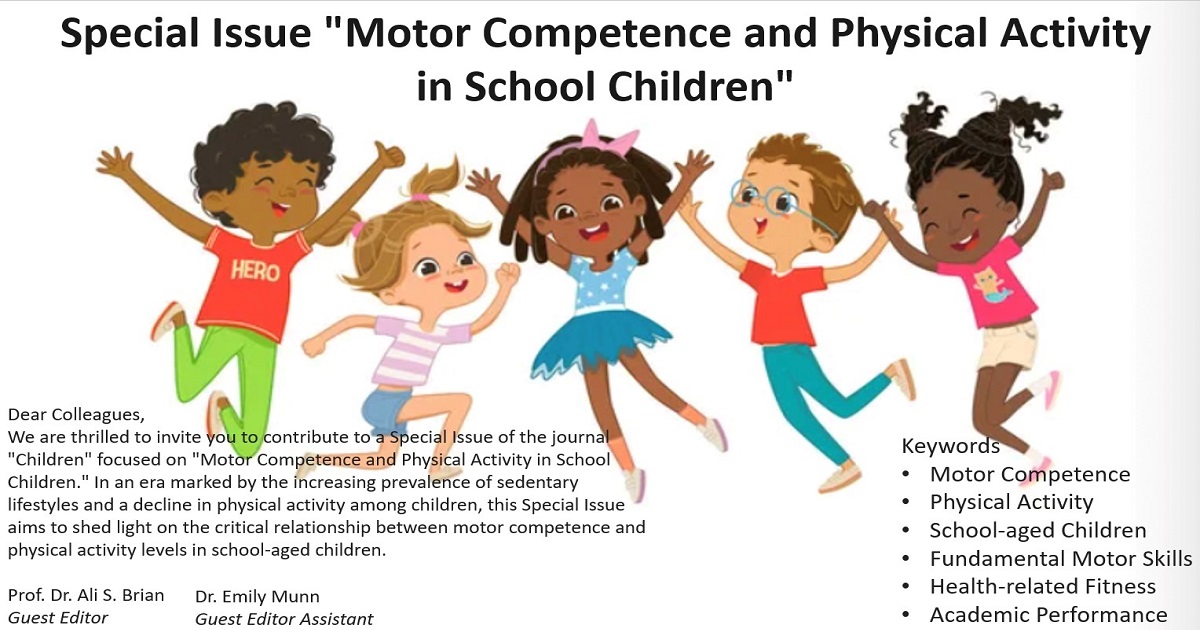- 2.1Impact Factor
- 3.8CiteScore
- 16 daysTime to First Decision
Advances in Motor Competence and Physical Activity in School Children
This special issue belongs to the section “Pediatric Orthopedics & Sports Medicine“.
Special Issue Information
Dear Colleagues,
We are thrilled to invite you to contribute this Special Issue of the journal Children focused on motor competence and physical activity in school children. In an era marked by the increasing prevalence of sedentary lifestyles and a decline in physical activity among children, this Special Issue aims to shed light on the critical relationship between motor competence and physical activity levels in school-aged children.
Considering the success and popularity of the Special Issue "Motor Competence and Physical Activity in School Children" previously published in the journal Children (https://www.mdpi.com/journal/children/special_issues/5928VHHTS0), we are releasing a follow-up Special Issue with the aim to provide a platform for researchers to explore various aspects of motor competence, ranging from fundamental motor skill development to the promotion of physical activity in educational settings. We encourage submissions that examine the impact of motor competence on overall health, academic performance and psychosocial well-being in children. By fostering a deeper understanding of these inter-related factors, we hope to inform strategies and interventions that can enhance the health and well-being of our youngest generation.
We look forward to receiving your innovative contributions, which will help shape the future of children's physical activity and motor competence research.
Prof. Dr. Ali S. Brian
Guest Editor
Dr. Emily Munn
Guest Editor Assistant
Manuscript Submission Information
Manuscripts should be submitted online at www.mdpi.com by registering and logging in to this website. Once you are registered, click here to go to the submission form. Manuscripts can be submitted until the deadline. All submissions that pass pre-check are peer-reviewed. Accepted papers will be published continuously in the journal (as soon as accepted) and will be listed together on the special issue website. Research articles, review articles as well as short communications are invited. For planned papers, a title and short abstract (about 250 words) can be sent to the Editorial Office for assessment.
Submitted manuscripts should not have been published previously, nor be under consideration for publication elsewhere (except conference proceedings papers). All manuscripts are thoroughly refereed through a single-blind peer-review process. A guide for authors and other relevant information for submission of manuscripts is available on the Instructions for Authors page. Children is an international peer-reviewed open access monthly journal published by MDPI.
Please visit the Instructions for Authors page before submitting a manuscript. The Article Processing Charge (APC) for publication in this open access journal is 2400 CHF (Swiss Francs). Submitted papers should be well formatted and use good English. Authors may use MDPI's English editing service prior to publication or during author revisions.
Keywords
- motor competence
- physical activity
- school-aged children
- fundamental motor skills
- health-related fitness
- academic performance

Benefits of Publishing in a Special Issue
- Ease of navigation: Grouping papers by topic helps scholars navigate broad scope journals more efficiently.
- Greater discoverability: Special Issues support the reach and impact of scientific research. Articles in Special Issues are more discoverable and cited more frequently.
- Expansion of research network: Special Issues facilitate connections among authors, fostering scientific collaborations.
- External promotion: Articles in Special Issues are often promoted through the journal's social media, increasing their visibility.
- e-Book format: Special Issues with more than 10 articles can be published as dedicated e-books, ensuring wide and rapid dissemination.

